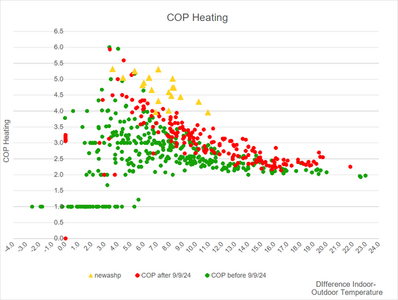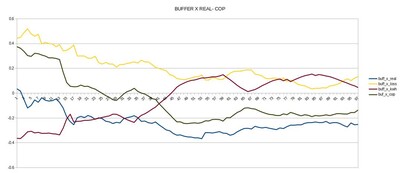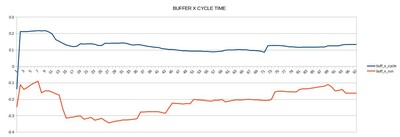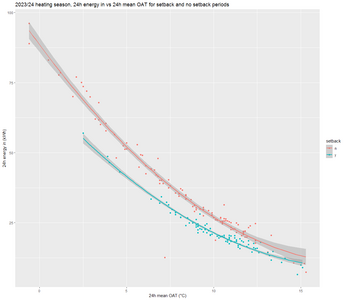Avoid the Heat Pump Villain: Why Low-Loss Headers and Buffers Can Sabotage Your Heat Pump's Efficiency
@potatoman as you already know a four-port buffer can cause heat pump inefficiencies due to uncontrolled blending of hot and cooler water, which reduces the supply temperature and forces the heat pump to work harder.
In contrast, a three-port buffer helps maintain stratification, reduces unnecessary mixing and ensures that the heat pump isn’t cycling. This improves efficiency and keeps return temperatures lower.
A volumiser, while not technically a hydraulic separator, can also satisfy most manufacturers’ minimum volume requirements. Its primary role is to provide thermal mass to prevent short cycling, but because it’s integrated more seamlessly into the system than a four-port buffer, it avoids distortion issues.
Ultimately, both the three-port buffer and the volumiser offer better solutions than a standard four-port buffer by reducing mixing, maintaining flow rates and ensuring the heat pump operates within its optimal parameters.
Get a copy of The Ultimate Guide to Heat Pumps
Subscribe and follow our YouTube channel!
Posted by: @potatoman@jamespa surely there must be a third way to improve efficiency, not just buffer or no buffer, but to balance a buffer, especially if you are using an open loop system.
Yes there is, provided the buffer is tall and well designed so there is stratification (forget 50l buffers so commonly fitted)
With one of these you have two temperature sensors and then you can detect where the thermocline (the division between cold water at the bottom and hot at the top) is. This information can be used to switch the secondary pump on or off to ensure its always in the middle section.
Alternatively you can attempt to do it 'open loop' by adjusting the pumps either side to run at the same speed. This only works fully with heat pumps that don't modulate the water pump speed to keep deltaT constant, unless they can modulate both water pumps, and with no valves that can switch on and off on the secondary side. Effectively you are adjusting the pumps to operate as if the buffer tank weren't present at all (underlining the fact that it is unnecessary!).
You can also adjust the secondary pump to be slightly slower than the primary, ensuring the thermocline is at the bottom and thus the flow to the emitters is at the same temp as the flow from the HP.
Any of these are likely to be better than doing nothing.
Posted by: @judiththey do allow a volumiser to be used, so the obvious question is could a 4 port buffer be configured as a volumiser and stay in warranty?
if that is the case then re-configuring it as a volumiser is the best thing to do. The answer to the question 'can this be done?' is yes.
4kW peak of solar PV since 2011; EV and a 1930s house which has been partially renovated to improve its efficiency. 7kW Vaillant heat pump.
Posted by: @potatoman@editor Thank you for the information,do you have any information or a link of how to pipe up a 3 port buffer
@heacol do you have any info to assist potatoman with this?
Get a copy of The Ultimate Guide to Heat Pumps
Subscribe and follow our YouTube channel!
I have an update. While the buffer to volumiser change (and removal of the extra circuation pump) was certainly a good thing, it seems that our main issue was simply the oversized heat pump. The installer (BG) now thankfully also swapped the 7kW for a 5kW ASHP (also Vaillant aerotherm plus) and our COP so far jumped up massively. See graph with the daily heating COP for different outdoor to indoor T differences. green: 7kW and buffer, red: 7 kW and vollumiser, yellow: 5kW and volumiser.
The flow rate of that 7kW unit was high, so there was also a big difference between the ASHP side and the circulation pump side on the buffer, so probably lots of mixing. Perhaps with the lower flow rate of the 5kW unit, the buffer configuration would not have been an issue, however it would have still been completely pointless in our case, and simpler is better.
Many thanks to British Gas, for actually sorting this out for us! I am overall very happy with their support.
THe ASHP has been really great to set up and provided very comfortable heat, and now finally we also have the good efficiency to save loads of CO2 emissions. I would boldly project that we might get a SCOP around 4 now.
We replaced our gas boiler, which wasn't too old and was still working, so it could be argued we shouldn't have swapped it, but we had a few recurring issues with leaks and defect parts at one point the leak also led to destroying our dishwasher below it. Now it also seems that it has been very inefficient indeed. We used around 10,000 kWh of gas to keep our house around 19-20degC. Now according to the Vaillant app we actually used around 6000 kWh of generated heat to keep the house around 20-21degC, so only around 60% efficient.
Assuming 75% boiler efficiency, head demand of 6000kWh per year and a SCOP of 4 (also assuming 0.309 kg CO2 per kWh electricity, and 0.185 kg CO2 per kWh gas), I calculate, we now save around 1000 kg CO2 per year!
Even at our worst SCOP with the previous ASHP unit, we still saved around 700 kg CO2 emissions per year.
Cost-wise, I would very roughly estimate that in around 12 years the expensive ASHP will have overtaken any initial savings if we had gone with a new gas boiler, however I think this calculation is a bit pointless. We would have saved 2000 GBP if we had had the current BUS grant, I don't know what a new boiler installation costs, etc. Mainly for us it was to reduce our CO2 emissions, and have a warm house with a better conscience also with regards to the war in Ukraine. Anyway, a decently efficient ASHP (SCOP 3.5) costs the same or less money to run compared to even a highly efficient a gas boiler (95%). In our case it seems we should now spend around 180 GBP less for heating per year.
Spreadsheet with my calculations (cost and CO2 emissions) attached.
Thats a brilliant result and you must be pleased you persisted with fighting this. Its also a good example of what I am beginning to suspect (but cant prove) namely that there is in fact absolutely nothing complicated or mysterious about getting ASHP installs to operate cost effectively for the vast majority of houses, it just needs to be simple (no buffer/LLH/PHE), right-sized, operated correctly and designed to work at a reasonably low flow temperature, none of which is particularly difficult and certainly none of which is mysterious. I am expecting the 'industry' to tell me I'm smoking the wrong dope!
I'm actually a little surprised that the switch from the 7kW to the 5kW made a significant difference as, elsewhere, I have heard people comment that their oversized Vaillants cope well. But its an important learning and makes Mitsubishi's latest 2-compressor approach (2+6kW in the same casing) even more worth watching.
Regarding running cost, it occurred to me only a couple of days ago how odd it is that many people cheerfully spend 10-20K upgrading their bathroom or kitchen with absolute no financial benefit and little benefit in utility, but the same people then question the payback period for swapping a gas boiler for an ASHP which, done properly, massively increases comfort and is a vital step to combat climate change. Strange things human beings!
FWIW I can now say with some confidence that my ASHP (right sized, simple system, running at FT42 @ -2) is costing ~20% less to run than my gas boiler compared like for like, and the house is much more comfortable. Like you I didn't do it for financial reasons, but of course its nice to have.
Thanks for reporting back, its always good to hear a success story and also that suppliers are recognising that oversized ASHPs with buffers just need to be fixed.
4kW peak of solar PV since 2011; EV and a 1930s house which has been partially renovated to improve its efficiency. 7kW Vaillant heat pump.
@fillib what a wonderful result, both for you personally and to prove the case that the recipe for good efficiency is right-sized ashp and volumiser and never llh. Having the results to show the difference is great too!
2kW + Growatt & 4kW +Sunnyboy PV on south-facing roof Solar thermal. 9.5kWh Givenergy battery with AC3. MVHR. Vaillant 7kW ASHP (very pleased with it) open system operating on WC
Posted by: @fillib
Assuming 75% boiler efficiency, head demand of 6000kWh per year and a SCOP of 4 (also assuming 0.309 kg CO2 per kWh electricity, and 0.185 kg CO2 per kWh gas), I calculate, we now save around 1000 kg CO2 per year!Even at our worst SCOP with the previous ASHP unit, we still saved around 700 kg CO2 emissions per year.
This is very impressive. I would not have expected the cop to increase to the extent of your graph as the ambient readings had dropped between esp between 10c and 3c…. Great result.
Further there’s another story, even if only for the environmental impact.
Your numbers potentially suggest that oversizing should be eliminated at all costs. With an estimated reduction of carbon emissions of upwards of 30%. Just by sizing correctly.
Thanks for a great post.
Posted by: @fillib
Spreadsheet with calculations (cost and CO2 emissions) attached.
@fillib It would be very interesting indeed to determine your actual house loss by plotting ASHP heat delivered vs OAT (eg on a daily basis). I looked in the spreadsheet but couldn't find the figures needed to do this.
The reason this would be interesting is to understand how oversized the 7kW model was. Based on 10MWh/yr gas consumption I would estimate your house loss to be 3.5-4kW, so perhaps as much as a factor of 2 oversized (more if your boiler is very inefficient) given that the 7kW model can actually do 8kW at typical FT and design OAT. I have heard others say that the Vaillant machines are reasonably good at coping with oversizing, but maybe not by a factor of 2! This plot from a John Cantor video illustrates the problem that heat pump designers have to grapple with:
It occurs to me that the fact that the heat pump was oversized may possibly have reduced the negative effect of the buffer. My understanding is that, by default, Vaillant heat pumps run mostly at fixed water pump speed which is adjusted at commissioning time (by the heat pump controller) according to the heat pump capacity. So yours will likely be running to achieve DT of ~5 at 7kW, but as your peak load is half this your DT will likely be in the 2-3 range even at peak load or less at a more normal load. This will reduce the temperature loss across the buffer due to mixing, thereby reducing its negative effect on COP. All of course assuming (amongst other things) that the Vaillant water pump does what it appears to do on my machine and what some others have said it does.
4kW peak of solar PV since 2011; EV and a 1930s house which has been partially renovated to improve its efficiency. 7kW Vaillant heat pump.
For me, the Questions are here:
1) Does a Volumiser tank needlessly consume more energy?
2) Does a Volumiser tank reduce wear by reducing cycling?
3) Does the COP vary with Water Flow rate?
To answer these questions I have recorded the performance of my heat pump when altering :
a) The primary water volume by switching in/out a 50 litre volumizer tank.
b) Altering the Water flow rates by applying a variable Pulse width Modulated , PWM Signal , to the primary Heat Pump inputs to my Heat Exchanger.
c) Altering the Water flow rates by applying a variable Pulse width Modulated , PWM Signal , to the secondary output from my Heat exchanger.
The Effects of altering the water volume, Primary and Secondary Heat Exchanger Water flow rate are shown in the following Cross Correlation graphs
A) ENERGY LOSS AND VOLUMIZER
The COP and the REAL_COP are shown to be Negatively Correlated with the use of the VOLUMIZER.
This implies that apply the buffer REDUCES BOTH the COP and the REAL COP.
This further implies that the VOLUMIZER wastes energy.
B) COP versus HEAT PUMP WATER FLOW RATE ( PWM)
The COP is here shown to be Positively Correlated with the RADIATOR WATER FLOW RATE.
This implies that increasing the Radiator PWM , hence, Reducing the Radiator Flow rate INCREASES the COP .
C) REAL_COP versus RADIATOR WATER FLOW RATE (PWM)
The REAL_COP is here shown to be NEGATIVELY Correlated with the HEAT PUMP OUTPUT WATER FLOW RATE.
This implies that increasing the HEAT PUMP PWM , Reducing the HEAT PUMP Flow rate, REDUCES the REAL_COP .
D) CYCLE AND RUN TIME Versus USE OF Volumizer TANK.
The Cycle Time is POSITIVELY Correlated with use of the Volumiser tank.
Using a Volumizing tank INCREASES the CYCLE TIME.
The RUN TIME is NEGATIVELY Correlated with the use of a Volumizing tank.
Using a Volumizing tank REDUCES the RUN TIME.
CONCLUSIONS:
1) A Volumizing tank increases energy loss.
2) A Volumising tank Increases CYCLE TIME and REDUCES Wear and tear.
3) Reducing the HEAT PUMP WATER FLOW RATE , Increasing the HEAT PUMP MOTOR PWM , Reduces the REAL_COP.
4) Reducing the Radiator WATER FLOW RATE , Increasing the Radiator MOTOR PWM , Increases the REAL_COP.
By Experiment my Heat Pump PWM is now set to 192 ms ( ~14 lpm) while my Radiator PWM is now set to 86 ms ( ~7 lpm) .
@iantelescope - I do appreciate I am becoming something of a harridan on your shoulder, but once again these graphs are impossible to interpret as posted, and even if I could make sense of them, the use of 'cross correlation' or even plain common or garden correlation to prove something is problematic because of the effects of uncontrolled variables.
On a positive note, you do state your research questions at the outset. But these questions are very difficult to answer in the real world. Take the first question: does a system with a volumiser use more energy than one without a volumiser? You can certainly make observations of both running states, and compare them, but the problem invariably is that the other variables don't stay constant. Imagine, for example, that the volumiser days happened more often to be cold days, with higher energy use and lower COPs, while the no volumiser days were warmer, with lower energy use and better COPs. In this entirely plausible example, you might conclude the volumiser uses more energy and impairs efficiency, when in fact the real explanation for what you observe is the differing OATs. To deal with this, you have to collect OAT data as well, and compare like with like, ie with/without volumiser on cold days, ditto for warm days etc etc. Even then, other factors can bias your results.
In many ways the underlying question here is the same as my setback vs no setback question: does changing a system running state affect energy use, where the change is a binary one, something is either on (with setback, with volumiser) or off (no setback, no volumiser). You could start by doing something similar to what I do: plot daily energy use against mean daily OAT for two series, in your case one with volumiser, one without, on the same chart. Here is a plot I did for setbacks in R, but the same thing can also be done in any spreadsheet. If you then see (as I did on this chart) what appears to be two samples from different populations (ie there appears to be a difference) then you can start asking whether it is real or not.
Midea 14kW (for now...) ASHP heating both building and DHW
-
British Gas Heat Pump Installation Complaint
1 month ago
-
Heating Turned Off but Radiators Still Warm
2 months ago
-
Samsung Heat pump with Yonos Pico circulating pump running all the time
2 months ago
-
Samsung 5kW R32 Monobloc Gen 6 ASHP
3 months ago
-
Ideal Logic 10kW Heat Pump Pipes Noisy and Very Expensive to Run
10 months ago
Currently viewing this topic 5 guests.
- 26 Forums
- 2,342 Topics
- 53 K Posts
- 346 Online
- 6,000 Members
Join Us!
Worth Watching
Latest Posts
-

RE: Who's your electricity provider and what's your tariff?
I've just received several emails saying OVO has axed i...
By Mars , 2 minutes ago
-

Actually, I don't; I would go with real world usage ove...
By Majordennisbloodnok , 24 minutes ago
-
RE: Octopus Cosy Heat Pump Owners & Discussion Thread
It would be useful if you can post back on here how tha...
By AndrewJ , 34 minutes ago
-
RE: Are We Sleepwalking Into Another Race to the Bottom?
this is why I provided current flow temperatures in the...
By ksim , 40 minutes ago
-

RE: Why Millions of UK Homes Struggle With Heat Pumps
There's many homes that would be quite a disruption for...
By dgclimatecontrol , 42 minutes ago
-
RE: Ecodan unable to hit legionella target temp - what's the consensus?
@rhh2348 ...maybe this option is what you want? Alter...
By benson , 45 minutes ago
-

RE: Free Ecoheat Heat Pump Install
@old_scientist This does make the unit smaller as the b...
By dgclimatecontrol , 51 minutes ago
-
OVO ending its Heat Pump Plus Tariff
I've just been emailed this by OVO: We’re sorry to ...
By Alex_N , 4 hours ago
-
RE: Ecodan - Legionella Operation Time and Target Temperature
@old_scientist hiya mate, did you ever get to the botto...
By 9jwr9 , 7 hours ago
-
RE: Advice on internal circulation pump noise
Welcome and I am sorry you are having this problem. &...
By JamesPa , 15 hours ago
-

RE: Heat Pump Heats the House… But It’s Not Cosy. Emitter Changes or System Tweak?
@alastair, in short, no, increasing emitter capacity wo...
By Mars , 17 hours ago
-
RE: Setback savings - fact or fiction?
Hi @cathoderay - this is a good discussion! I feel like...
By RobS , 18 hours ago
-
RE: Configuring third party dongle for Ecodan local control
@majordennisbloodnok I think the HPDHD diagnosis may be...
By Sheriff Fatman , 20 hours ago
-

RE: External pipework insulation
I don't think we can tell from a photo whether your exi...
By Transparent , 20 hours ago
-
RE: Controlling Daikin Altherma via P1P2 and Home Assistant
@majordennisbloodnok That’s correct. I can’t find anywh...
By weoleyric , 1 day ago
-

RE: A Smarter Smart Controller from Homely?
@papahuhu I hope you get a swift resolution. Regards, T...
By Toodles , 2 days ago
-

RE: Poll for Time of Use, tariffs, technology
That’s fine by me too Major, I feel it is a sad reflect...
By Toodles , 2 days ago
-

Bingo. Sometimes a judiciously placed size 10 bovver bo...
By Majordennisbloodnok , 2 days ago














